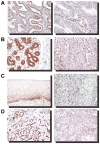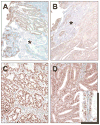Mutation and loss of expression of ARID1A in uterine low-grade endometrioid carcinoma
- PMID: 21412130
- PMCID: PMC3077471
- DOI: 10.1097/PAS.0b013e318212782a
Mutation and loss of expression of ARID1A in uterine low-grade endometrioid carcinoma
Abstract
ARID1A is a recently identified tumor suppressor gene that is mutated in approximately 50% of ovarian clear cell and 30% of ovarian endometrioid carcinomas. The mutation is associated with loss of protein expression as assessed by immunohistochemistry. In this study, we evaluated ARID1A immunoreactivity in a wide variety of carcinomas to determine the prevalence of ARID1A inactivation in carcinomas. Mutational analysis of ARID1A was carried out in selected cases. Immunoreactivity was not detected (corresponding to inactivation or mutation of ARID1A) in 36 (3.6%) of 995 tumors. Uterine low-grade endometrioid carcinomas showed a relatively high-frequency loss of ARID1A expression, as 15 (26%) of 58 cases were negative. The other tumor that had a relatively high-frequency loss of ARID1A expression was gastric carcinoma (11%). Mutational analysis showed 10 (40%) of 25 uterine endometrioid carcinomas; none of 12 uterine serous carcinomas and none of 56 ovarian serous and mucinous carcinomas harbored somatic ARID1A mutations. All mutations in endometrioid carcinomas were nonsense or insertion/deletion mutations, and tumors with ARID1A mutations showed complete loss or clonal loss of ARID1A expression. In conclusion, this study is the first large-scale analysis of a wide variety of carcinomas showing that uterine low-grade endometrioid carcinoma is the predominant tumor type harboring ARID1A mutations and frequent loss of ARID1A expression. These findings suggest that the molecular pathogenesis of low-grade uterine endometrioid carcinoma is similar to that of ovarian low-grade endometrioid and clear cell carcinoma, tumors that have previously been shown to have a high-frequency loss of expression and mutation of ARID1A.
Figures




